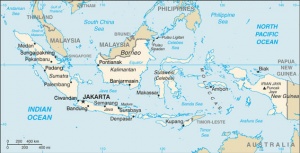Indonesia Statistics
| Embryology - 27 Apr 2024 |
|---|
| Google Translate - select your language from the list shown below (this will open a new external page) |
|
العربية | català | 中文 | 中國傳統的 | français | Deutsche | עִברִית | हिंदी | bahasa Indonesia | italiano | 日本語 | 한국어 | မြန်မာ | Pilipino | Polskie | português | ਪੰਜਾਬੀ ਦੇ | Română | русский | Español | Swahili | Svensk | ไทย | Türkçe | اردو | ייִדיש | Tiếng Việt These external translations are automated and may not be accurate. (More? About Translations) |
Introduction
This page links to the current online resources available to explore Indonesian population and birth data.
Indonesia is the fourth most populace country in the world, by 2032 it is projected to have more than 300 million people.
| Statistics Links: Introduction | Reports | World Population | World Fertility | World Infant Mortality | Maternal Mortality | Australia | Brazil | Canada | China | Germany | India | Indonesia | Europe | Myanmar | Netherlands | Spain | United Kingdom | Romania | Uganda | United States | BGD Tutorial - Applied Embryology and Teratology | National Perinatal Statistics Unit | AIHW | Category:Statistics | |
|
Some Recent Findings
| More recent papers |
|---|
|
This table allows an automated computer search of the external PubMed database using the listed "Search term" text link.
More? References | Discussion Page | Journal Searches | 2019 References | 2020 References Search term: Indonesia Embryology <pubmed limit=5>Indonesia Embryology</pubmed> |
General Statistics
Population 245,613,043 (July 2011 est.) country comparison to the world: 4
Age structure
- 0-14 years: 27.3% (male 34,165,213/female 32,978,841)
- 15-64 years: 66.5% (male 82,104,636/female 81,263,055)
- 65 years and over: 6.1% (male 6,654,695/female 8,446,603) (2011 est.)
Median age
- total: 28.2 years
- male: 27.7 years
- female: 28.7 years (2011 est.)
Population growth rate
- 1.069% (2011 est.)
- country comparison to the world: 111
Birth rate
- 18.1 births/1,000 population (2011 est.)
- country comparison to the world: 105
- low birthweight 9 % (2008-2012)
Death rate
- 6.26 deaths/1,000 population (July 2011 est.)
- country comparison to the world: 156
Sex ratio
- at birth: 1.05 male(s)/female
- under 15 years: 1.04 male(s)/female
- 15-64 years: 1.01 male(s)/female
- 65 years and over: 0.79 male(s)/female
- total population: 1 male(s)/female (2011 est.)
Infant mortality rate
- total: 27.95 deaths/1,000 live births
- country comparison to the world: 72
- male: 32.63 deaths/1,000 live births
- female: 23.03 deaths/1,000 live births (2011 est.)
| Infant Mortality Rate | |||||||||
|---|---|---|---|---|---|---|---|---|---|
| 1971 | 1980 | 1990 | 1994 | 1997 | 2000 | 2002 | 2007 | 2010 | 2012 |
| 145 | 109 | 71 | 66 | 52 | 47 | 43 | 39 | 26 | 34 |
Life expectancy at birth
- total population: 71.33 years
- country comparison to the world: 137
- male: 68.8 years
- female: 73.99 years (2011 est.)
Total fertility rate
2.25 children born/woman (2011 est.) country comparison to the world: 103
Major infectious diseases
- degree of risk: high
- food or waterborne diseases: bacterial diarrhea, hepatitis A and E, and typhoid fever
- vectorborne diseases: chikungunya, dengue fever, and malaria
Data: The World Factbook Indonesia
Nutrition
| Low birthweight (%) 2008-2012* | 9 |
| Early initiation of breastfeeding (%), 2008-2012* | 29.3 |
| Exclusive breastfeeding <6 months (%), 2008-2012* | 41.5 |
| Introduction of solid, semi-solid or soft foods 6-8 months (%), 2008-2012* | 84.6 |
| Breastfeeding at age 2 (%), 2008-2012* | 55.3 |
| Underweight (%) 2008-2012*, moderate & severe | 17.9 |
| Underweight (%) 2008-2012*, severe | 4.9 |
| Stunting (%) 2008-2012*, moderate & severe | 35.6 |
| Wasting (%) 2008-2012*, moderate & severe | 13.3 |
| Overweight (%) 2008-2012*, moderate & severe | 12.3 |
| Vitamin A supplementation full coverage (%) 2012 | 73 |
| Iodized salt consumption (%) 2008-2012* | 62.3 |
Data 2013: UNICEF Statistics Low birthweight - Demographic and Health Surveys (DHS), Multiple Indicator Cluster Surveys (MICS), other national householdsurveys and data from routine reporting systems; Breastfeeding - DHS, MICS, and UNICEF; Underweight, wasting and stunting - DHS, MICS, World Health Organization (WHO) and UNICEF; Salt iodization - MICS, DHS and UNICEF; Vitamin A - UNICEF field offices and WHO.
External Links
External Links Notice - The dynamic nature of the internet may mean that some of these listed links may no longer function. If the link no longer works search the web with the link text or name. Links to any external commercial sites are provided for information purposes only and should never be considered an endorsement. UNSW Embryology is provided as an educational resource with no clinical information or commercial affiliation.
Glossary Links
- Glossary: A | B | C | D | E | F | G | H | I | J | K | L | M | N | O | P | Q | R | S | T | U | V | W | X | Y | Z | Numbers | Symbols | Term Link
Cite this page: Hill, M.A. (2024, April 27) Embryology Indonesia Statistics. Retrieved from https://embryology.med.unsw.edu.au/embryology/index.php/Indonesia_Statistics
- © Dr Mark Hill 2024, UNSW Embryology ISBN: 978 0 7334 2609 4 - UNSW CRICOS Provider Code No. 00098G
- ↑ <pubmed>26405399</pubmed>



